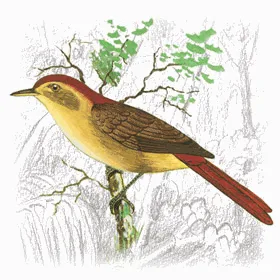
Chestnut-crowned Foliage-gleaner
[order] Passeriformes | [family] Furnariidae | [latin] Automolus rufipileatus | [UK] Chestnut-crowned Foliage-Gleaner | [FR] Anabate a couronne rousse | [DE] Rostkappen-Baumspaher | [ES] Ticotico Coronicastano | [IT] Spigolafoglie corona rossiccia | [NL] Roodkruinbladspeurder
Subspecies
| Genus | Species | subspecies | Breeding Range | Breeding Range 2 | Non Breeding Range |
| Automolus | rufipileatus | SA | Amazonia | ||
| Automolus | rufipileatus | consobrinus | |||
| Automolus | rufipileatus | rufipileatus |
Physical charateristics
Mantle and wings reddish brown. Crown, and tail rufous chestnut, underparts light brown and throat buff. Feathers of crown elongated. The sexes are alike.
Listen to the sound of Chestnut-crowned Foliage-Gleaner
[audio:http://www.aviflevoland.nl/sounddb/C/Chestnut-crowned Foliage-Gleaner.mp3]
Copyright remark: Most sounds derived from xeno-canto
| wingspan min.: | 0 | cm | wingspan max.: | 0 | cm |
| size min.: | 18 | cm | size max.: | 19 | cm |
| incubation min.: | 0 | days | incubation max.: | 0 | days |
| fledging min.: | 0 | days | fledging max.: | 0 | days |
| broods: | 0 | eggs min.: | 0 | ||
| eggs max.: | 0 |
Range
Found in Bolivia, Brazil, Colombia, Ecuador, Peru, Venezuela and the Guianas. In Suriname widespread in the interior but only locally common.
Habitat
Riverine forests especially bamboo and thickets of cane. Sometimes and locally in terra firme bamboo patches. In Matto Gosso state of Brazil, the Chestnut-crowned Foliage-Gleaner is reported to be confined largely to stands of bamboo in the forest. In Eastern Peru, the same species is also strongly associated with bamboo, but is also known to occur in canebrakes and treefall gaps. More heard then seen.
Reproduction
No data.
Feeding habits
Hunts for insects and small vertebrates in dense understorey and subcanopy. Forages in pairs or in mixed flocks by gleaning prey from mostly dead leafs.
Conservation
This species has a large range, with an estimated global extent of occurrence of 4,000,000 km2. The global population size has not been quantified, but it is believed to be large as the species is described as ‘frequent’ in at least parts of its range (Stotz et al. 1996). Global population trends have not been quantified, but the species is not believed to approach the thresholds for the population decline criterion of the IUCN Red List (i.e., declining more than 30% in ten years or three generations). For these reasons, the species is evaluated as Least Concern.

Migration
Sedentary throughout range.
Distribution map

]]>
